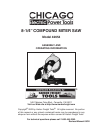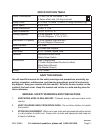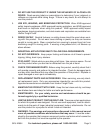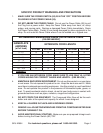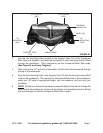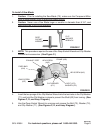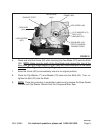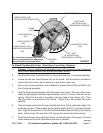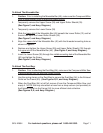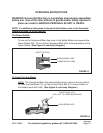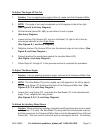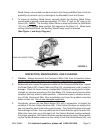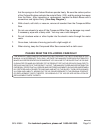
Page 5SKU 42654
For technical questions, please call 1-800-444-3353.
DO NOT USE THIS TOOL FOR CUTTING METALS OR BRITTLE MATERIALS.
Do not cut dangerous materials, such as asbestos that can cause harmful dust or
vapors.
ALLOW THE SAW BLADE (70) TO SPIN UP TO FULL SPEED BEFORE FEEDING
WOOD INTO IT. When turning it off, allow the Saw Blade to spin down and stop on
its own. Do not press against the Saw Blade to stop it.
NEVER PASS HANDS DIRECTLY UNDER THE SAW BLADE (70) WHEN CUT-
TING THE WORK PIECE. Always keep hands and fingers a safe distance away
from the moving Saw Blade.
DO NOT FORCE THE MATERIAL INTO THE SAW BLADE (70) WHEN CUTTING.
Apply moderate pressure, allowing the Saw Blade to cut without being forced.
NEVER ATTEMPT TO REMOVE MATERIAL STUCK IN THE MOVING PARTS OF
THE COMPOUND MITER SAW WHILE IT IS PLUGGED IN AND RUNNING.
TURN OFF THE COMPOUND MITER SAW IF THE BLADE IS TO BE BACKED
OUT OF AN UNCOMPLETED CUT.
MAKE SURE THE WORK PIECE IS FREE FROM NAILS AND ANY OTHER FOR-
EIGN OBJECTS WHICH COULD DAMAGE THE SAW BLADE (70).
ALWAYS FEED THE WORK PIECE INTO THE SAW BLADE (70) AND AGAINST
ITS ROTATION.
MAKE SURE THE WORK PIECE IS SUPPORTED AT ALL TIMES DURING OPERA-
TION. Use a Roller Stand (not provided) with larger work pieces if necessary.
BEFORE TRYING NEW OR COMPLICATED TECHNIQUES, STUDY THE PRO-
CEDURE AND PRACTICE WITH SCRAP WOOD.
ALWAYS DISCONNECT THE COMPOUND MITER SAW FROM ITS ELECTRICAL
SUPPLY SOURCE BEFORE PERFORMING ANY SERVICES OR MAINTENANCE.
Make sure to turn off the Compound Miter Saw when leaving the work area, moving
the tool from one location to another, changing Saw Blades (70), cleaning sawdust
from the unit, etcetera.
WARNING: People with pacemakers should consult with their physician(s)
before using this product. Operation of electrical equipment in close proximity to
a heart pacemaker could cause interference or failure of the pacemaker.
WARNING: Some dust created by power sanding, sawing, grinding, drilling,
and other construction activities, contain chemicals known (to the State of
California) to cause cancer, birth defects or other reproductive harm. Some
examples of these chemicals are: lead from lead-based paints, crystalline silica
from bricks and cement or other masonry products, arsenic and chromium from
chemically treated lumber. Your risk from these exposures varies, depending on
9.
10.
11.
12.
13.
14.
15.
16.
17.
18.
19.
20.
21.



